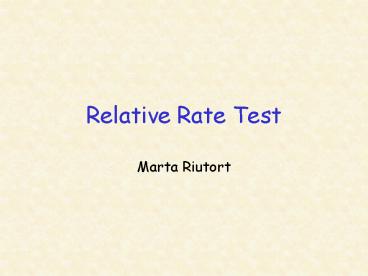Relative Rate Test
1 / 18
Title: Relative Rate Test
1
Relative Rate Test
- Marta Riutort
2
The molecular clock
- Is not perfect
- the nucleotid substitution rate, from a strict
point of view, is never the same for all the
lineages we compare - This heterogeneity of rates generally is not
going to have consequences in the inference of
phylogenies, however
3
Long branch attraction (LBA)
- When the length of the branches or the
substitution rates are extremely unequal, there
is a violation of the assumptions made by
inference methods that can produce the
inconsistency of any of those methods - We are entering the Felsenstein Zone
4
Felsenstein zone
5
Felsenstein zone
Filogenia real
Filogenia estimada
6
(No Transcript)
7
Equinodermo
DEUTEROSTOMADOS
Cefalocordado
Artrópodo
Nemertino
Molusco
Anélido
Políclado
Macrostómido
Nemertodermátido
PROTOSTOMADOS
94
Proseriado
Catenúlido
Rhabdocelo
100
Tríclado
Tríclado
Nemátodo-1
Nemátodo-2
Cnidario
Placozoo
0.10
Ctenóforo
Coanoflagelado
8
equinodermo-1
DEUTEROSTOMADOS
hemicordado-1
cordado-1
cordado-2
artrópodo-1
artrópodo-2
nematomorfo-1
nematodo-1
Ecdisozoos
priapúlido-1
kinorrinco-1
nemertino-1
sipuncúlido-1
anélido-1
Lofoforados Eutrocozoos
molusco-1
PROTOSTOMADOS
anélido-2
lofoforado-1
molusco-2
pogonóforo-1
anélido-3
lecitoepiteliado
proseriado
nemertodermátido
prolecitoforado
Platelmintos
catenulado
catenulad
macrostómido
macrostómido
políclado
ctenóforo
porífero
cnidario
9
fast-clock organisms
- These organisms with long branches are called
fast-clock - They really acumulate substitutions faster than
the rest of organisms (their rate of substitution
is higher) - Some authors have proposed various hypothesis to
try to explain this phenomenon - higher metabolic rate, shor generation time,
differences in the number of replications of DNA
inthe germinal line, deficiences in DNA repair,
mutagens,
10
Solutions?
- Use methods less sensible to this type of
inconsistency (ML?) - If it is possible, eliminate long branches
- eliminate the fast-clock organism
- substitute by another of the same group that is
not fast-clock - increase the number of organisms of that group
11
Solutions?
- We first need to know if we really have a
fast-clock organism - Relative Rate Test
- Sarich and Wilson, 1973 for proteins
- Wu and Li (1985) and Li and Tanimura (1987)
extend it to nucleotides
12
Relative Rate Test
- Uses 3 species A, B and one outgroup C
- Tests if A and B have the same rate of
substitution since their split - dAO dBO
- dAC dBC
- d dAC - dBC 0
13
Relative Rate Test
- This method is time independent
- We have to be sure about the phylogeny
14
Relative Rate Test
- Our nule hypothesis is
- d dAC - dBC 0
- It is assumed that the number of nucleotide
substitutions follows a Poisson, - then we can use the standarized normal
distribution to test if the number of
substituions in the 2 lieages is the same
15
Relative Rate Test
- d dAC - dBC 0
- d Var(d)
- Var(d) Var(dAC) Var(dBC) - 2 Cov (dAC,dBC)
- Si
- d gt 1,96 Var(d) test is significative at 5
level - d gt 2,96 Var(d) test is significative at 1
level
16
- Si
- d gt 1,96 Var(d) el test es significativo al 5
- d gt 2,96 Var(d) el test es significativo al 1
- Hipótesis nulad dAC - dBC 0
0
17
Equinodermo
DEUTEROSTOMADOS
Cefalocordado
Artrópodo
Nemertino
Molusco
Anélido
Políclado
Macrostómido
Nemertodermátido
PROTOSTOMADOS
94
Proseriado
Catenúlido
Rhabdocelo
100
Tríclado
Tríclado
Nemátodo-1
Nemátodo-2
Cnidario
Placozoo
0.10
Ctenóforo
Coanoflagelado
18
Relative Rate Test































